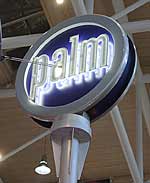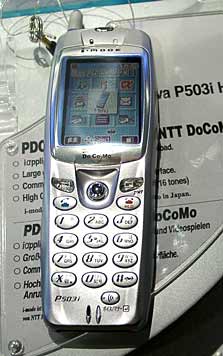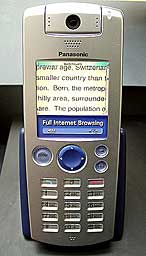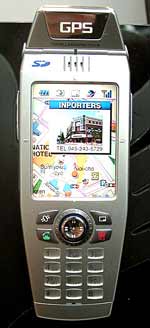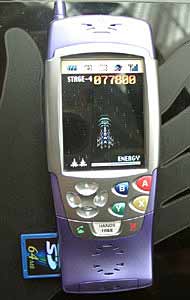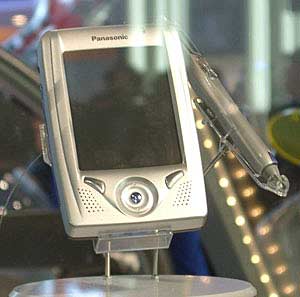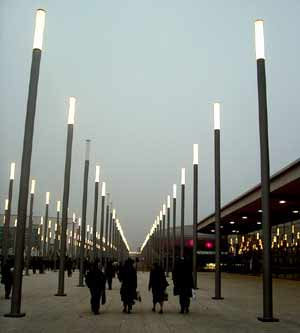Palm and his ilk
Recent Smartphones Palm OS, at first glance, almost none. Produced by Kyocera (formerly Qualcomm) does not count because it only works on CDMA networks, and can not be considered a novelty, even a stretch. Is that the Samsung was lit, but the seriousness of his intentions until the doubt.
However, to be closer, it becomes clear: manufacturers of devices on the Palm OS simply does not have to expend energy on the creation of specialized devices-smartphones. Their approach: making and selling such handheld computers, which if necessary can be turned into smart flick of the wrist. The basic idea: the concept of separation of CPC and the cell phone - perfect. The user is more convenient to have two little handy device than a single relatively large and not too convenient. Just the right moment CPC must easily and securely connect to your phone, making him whole.
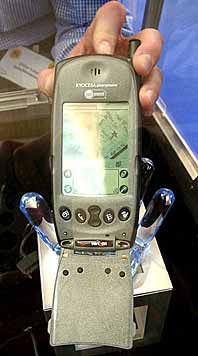 |
In the long term for such a "transparent" connection can be applied BlueTooth. So far, no physical contact devices can not do, Palm offers turn your PDA into smart phones via special modules, tips from third parties. A pair of samples was represented at the Palm booth companies Ubinetics and RealVision. His version of GSM-module, complete with various services offered by OmniSky. Thanks to the openness of technical documentation production of such nozzles can do anyone. The cause of Taiwanese took, and has proposed several options for relatively low-cost GSM-modules for Palm Series V. The most advanced units can exist separately from the PDA, and used at the same time to receive calls and incoming SMS-messages. To read messages, post your own and dial when calling to add Palm to the nozzle and run a special program. If you prefer, you can rewrite some phones from address book to Palm SIM-card phone. Some units have built-in memory chip for long-term storage of information about incoming calls and text messages, and even a microphone with a speaker to communicate without the Hands-Free. By separating functions of the phone and the computer user can work with each device separately, combining them together only when necessary. In addition, devices use different batteries, so if you discharge your phone, you can safely continue to use the PDA. The same approach was that the company Handspring, actively promoting VisorPhone - Cell phone GSM or CDMA Pocket PC Visor various modifications. Only if the communication between the Palm Vx and the GSM-module is serial, then in the case of the Visor GSM-module connects via an expansion slot Springboard. We should expect that with the advent of new Palm'ov series m5xx inevitably appears a miniature telephone with SD-card interface.
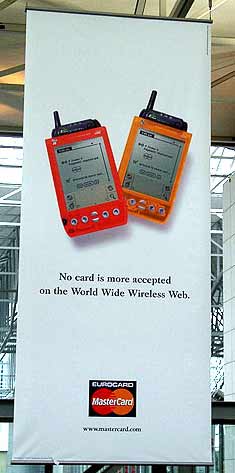 |
The total cost solutions Palm + GSM-module or Visor + VisorPhone ranges from 700 to $ 900 Price depends on the model of Pocket PC and ambitions of GPS-equipment supplier. And yet. One of Taiwan's firmochek shown at the exhibition messenger for Palm Vx, in the shape of the plug. The cost of this device - 50-70 dollars, far below the cost of GSM-module, and can be used for one-way communication.I am afraid that cheap pagers for Palm overdue for a couple of years, and today they are unlikely to attract a lot of fans.
Motorola secret in
After a not too successful completion of a joint project with the smartphone Psion, Motorola showed no special novelties. More precisely, a new smartphone on the stand still had - Accompli 008. Very interesting development, the size of slightly more than a pager. Good graphical display 320x240, but is physically much smaller than the Pocket PC, besides actually use less space than advertised. Naturally, the possibility of a good organizer with synchronization system Starfish. Touch screen, entering data with a virtual keyboard, a handwriting recognition system or voice commands. Ports the exchange of RS-232 and IrDA. It is curious that the Accompli 008 has two language versions - English and Chinese. The smartphone allows for the development and add more applications, but development tools for the 008 model yet. It can be assumed that Motorola would not violate the usual principles and publish the SDK in the public domain. In addition to the Accompli 008, some previous models of smart phones and conventional phones, Motorola's booth was a showcase of the conceptual developments in the smartphone field telephone. Nothing particularly outstanding, with similar products made from papier-mache can be in the range found on the pages of the WWW, however, the cost to get the camera as one of the stand staff started moving in my direction with a known gesture, "remove the camera." Strange people, why show at the exhibition that it is impossible to photograph? The desire to shoot at Motorolovskom stand (quite incidentally, a dark and expressionless) I was lost, so 008 pictures you will not see here.
Ericsson is also well put new items
It was rumored that Ericsson shows a new device. Like, someone even saw it, and even photographed ... but on the company's stand at 26-m pavilion is nothing like a smartphone I could not be found. If such is certainly not regarded as an unfinished R380, which exhibited more than modest.
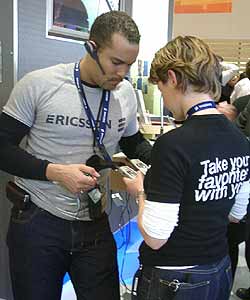 |
But some innovations in the field of data transmission Ericsson yet demonstrated. For example, a R520 phone with an infrared port and support for GPRS. I could not resist the temptation to pretend tea: - Is it true that the production of rolled Ericsson mobile phones? Guy Erickson typical form, hung with telephones, pagers, headsets and other wireless Baubles, replied: - It's all nonsense! We just handed over the mass production of the third company to focus on major developments and tabloid journalists trumpeted to the world ... We have talked a bit about the problems of outsourcing. Then he kept telling me about the benefits of technology Bluetooth. Then he complained about what went fingered visitor - they have two days were separated from the tables of a bunch of tubes. And then I went to watch the development of a series of Home Products. The most interesting was, of course, Cordless Web Screen H610 - home plate for viewing Internet pages. Next to the phone jack installed base station and Web Screen can be worn on an apartment anywhere. Screen - above all praise, especially when you consider "home" nature of the device. There is a special stand to read the table. However, for domestic users Web Screen - useless thing, because of the existence of the Cyrillic alphabet, it does not know, and teach her Russian is not possible due to lack of necessary tools. Ericsson still showed some strange device like a radio with an e-mail, fax, SMS, WAP, GPRS, and all such other things. Lie, of course, the features have been smaller, but still do not understand why all this is necessary. It is a pity that it was not possible to see interesting products on EPOC, but pretty boring R380. Hid everything so that the dogs did not find.
Speaking of Symbian
Stand development company near the cellular giants looked modestly. Prototypes and concepts are not shown, the people was breaking. Still working. The emergence of devices on the Quartz not expected until late summer, and did not specify that it will be for the device. Quartz for distributing free SDK, for Crystal and Pearl - yet nothing is done, come back tomorrow. As promised, EPOC R6 supports Unicode, let alone how to use this support to vendors - this is purely in their competence. Therefore the work on localization devices R6 may not be less interesting than it was with the previous R5. We will wait for good news.
Matsushita is working on the Japanese market
Matsushita presence at the exhibition was more than noticeable, thanks to numerous balloons - mobile phones Panasonic - in the hands of children and adults, as well as in the skies over the show. On a blue bench Panasonic drew my attention phone GD95. - And with a computer it can be synchronized?
- No.
- A color screen is?
- No.
- A. ..
- Look out on the table. There, everything is there. "At the table" were telefonchik that Matsushita releases for the Japanese network of NTT DoCoMo. And they do everything. Including iMode instead of a wretched European WAP.
Conceptual prototypes were shown side by side for third generation networks. Color screens, GPS-navigation, Toys, Internet, wireless video surveillance system and has all sorts of vehicles of the future. Above all this in the air hovered a device very attractive appearance, but with an unknown filling. People at the booth was much larger than our free time, so we did not stick to the managers, and ran to look for work samples.
Acer borrows design, but is developing its own OS
Another device shown palmoobraznoe Acer. Rare case when the prototype demonstrates the complete set: a glass lay all sorts of accessories. Even without them, very clearly, why Acer "lapped up" your smartphone: the same size, same bend the lower body. None of the usual graffiti, larger screen resolution, its own operating system, and only three buttons. A body and a picture on the screen - well, twins. Is Palm still so much requests for a license, which is cheaper everything themselves from scratch to develop? By the way, the concept of "shared smartphone" also borrowed from the Palm. GSM-unit Acer'a is a separate module that attaches itself to your phone from the back side, like a GSM-module for the Palm Vx.
| More smart, good and different "width =" 150 "height =" 243 "/> |
No keyboard or pen input
Another interesting device has demonstrated a small Scandinavian company Spectronic AB. Their smartphone, as expected, can accept, send emails and faxes from him, you can view the page WWW. Organayzernye functions, notebook and other Outlook'i also present. Among other things, the device has built-in digital camera and the rather big size of the radio station. Black and white screen 640x200 takes up the entire front panel. In order to increase the strength of the screen is covered with a thick protective glass. Similarity with the radio station is further enhanced by a thin flexible antenna. Information input, management and navigation is carried out with the help of technology Sidetouch. Translated into Russian - buttons hidden under the large rubber pads on the sides of the phone. Stand assistant consultant argued that it is very simple, fast and convenient, we just need a little practice. I, however, did not seem so. One thing at a smartphone after all should have: some kind of no keyboard or touch screen.
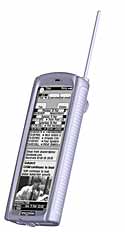 |
By the way, include the product from Spectronic to this smartphone does not allow the inability to create and install additional applications. A sort of "thing in itself." At the booth to photograph the phone failed, so the image is borrowed from the manufacturer (www.spectronic.se) * * * survey all interesting in the PDA field there was absolutely no possibility of too much of a show. However, the basic trends were clear in the past: - Microsoft sure that the user needs it all at once, more, more abruptly, and expensive;
- Palm espouse the opposite: you first need to give the most necessary, and then people will understand what else he needs, and buy extra;
- Symbian something hard does, but nobody says anything. Perhaps soon we are all very surprised and start to live a new life;
- Others believe that they themselves with a mustache, and outsiders do not need advice. This, of course, a joke (April 1 on the nose, after all). And some of the very serious developments, see the next part.
The authors, translation:
Andrey Kuznetsov
